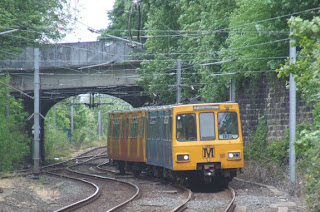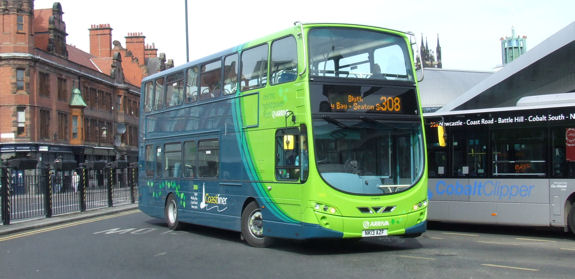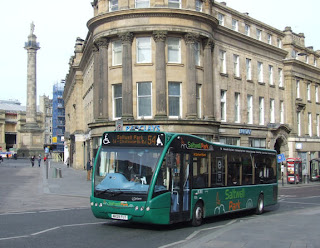England's northernmost city is Newcastle-upon-Tyne. There are other settlements further north, between Newcastle and the border with Scotland, but none of these has city status.
Newcastle itself is home to roughly a quarter of a million people. The Tyneside conurbation, which combines Newcastle with surrounding towns (including neighbouring Gateshead which faces Newcastle on the opposite side of the River Tyne), is one of the largest in England with a population of nearly 900,000.
 There are plenty of buses on Newcastle's streets. With the exception of Greater London, bus services in Great Britain are deregulated. Operators have commercial freedom to operate where and when they choose.
There are plenty of buses on Newcastle's streets. With the exception of Greater London, bus services in Great Britain are deregulated. Operators have commercial freedom to operate where and when they choose.
Buses in Newcastle are generally operated by one of three companies - Stagecoach, Arriva or Go North East.
Many of the services operating entirely within Newcastle are generally operated by Stagecoach with a fleet comprising single-deck and double-deck vehicles. All have a single entrance/exit.
 Although much of the Stagecoach network is contained within Newcastle, some services cross the boundary.
Although much of the Stagecoach network is contained within Newcastle, some services cross the boundary.
I found this vehicle, with "waves" branding, operating a service to the South Tyneside coast.
Route 100 provides an intensive link between Newcastle and the Metrocentre, a large out-of-town shopping centre on the south side of the Tyne. Buses used on route 100 carry dedicated Metrocentre branding.
Stagecoach operate a number of hybrid-powered double-deckers. These carry a variation of the corporate colour scheme to highlight their "green" credentials.
Of the services operated by Arriva, most run from Newcastle out to destinations within North Tyneside and further northwards. A mix of midibus, single-deck and double-deck vehicles is operated.
 Arriva operate one service southwards from Newcastle to Durham, while their 685 service is a long-distance route heading westwards across the north of England to Carlisle. I found coaches and single-deck buses at work on the 685 when I visited Newcastle at Easter 2013.
Arriva operate one service southwards from Newcastle to Durham, while their 685 service is a long-distance route heading westwards across the north of England to Carlisle. I found coaches and single-deck buses at work on the 685 when I visited Newcastle at Easter 2013.
Arriva also operate hybrid double-deckers. These carry a "green" version of their operator's corporate livery.
 Go North East operate an extensive network of services into Newcastle, particularly from other parts of the Tyneside conurbation as well as places further south and west.
Go North East operate an extensive network of services into Newcastle, particularly from other parts of the Tyneside conurbation as well as places further south and west.
Rather than having a single livery for the whole fleet, Go North East's services carry an array of brand identities. Some of the brands apply to individual single routes while others are used on pairs or groups of routes which combine to serve a major flow.

 Routes 56 to Sunderland and 57 to South Tyneside are branded individually as "Fab56" (orange colour scheme) and "Fab57" (blue).
Routes 56 to Sunderland and 57 to South Tyneside are branded individually as "Fab56" (orange colour scheme) and "Fab57" (blue). The Derwent Valley, south west of Newcastle, is one of several locations where a population of red kites has been successfully reintroduced in recent years.
The Derwent Valley, south west of Newcastle, is one of several locations where a population of red kites has been successfully reintroduced in recent years.
Go North East routes 45 and 46, serving the Derwent Valley, acknowledge this initiative with their "Red Kite" branding.
 Several routes operating into Newcastle are operated with double-deck buses. Like the single deckers, these have a single entrance/exit.
Several routes operating into Newcastle are operated with double-deck buses. Like the single deckers, these have a single entrance/exit.
Go North East's "Tyne Tees Xpress" brand is used for a pair of longer-distance, limited-stop routes which link Newcastle with Middlesbrough.
 The "Angel" brand is a reference to the iconic Angel of the North landmark in Gateshead, a short distance from Newcastle. The brand is used for trunk route 21 which links Newcastle with Durham (a corridor also served by an Arriva route). A fleet of hybrid-powered double-deck buses operated the "Angel" service.
The "Angel" brand is a reference to the iconic Angel of the North landmark in Gateshead, a short distance from Newcastle. The brand is used for trunk route 21 which links Newcastle with Durham (a corridor also served by an Arriva route). A fleet of hybrid-powered double-deck buses operated the "Angel" service. Articulated buses aren't a common sight in the UK. However, Go North East operates a small fleet of them. Those on route 58, a service which operates across Newcastle City Centre, are branded Citylink.
Articulated buses aren't a common sight in the UK. However, Go North East operates a small fleet of them. Those on route 58, a service which operates across Newcastle City Centre, are branded Citylink. The vehicles originally operated in London, until a political decision led to their removal. In London, they operated in three-door format with entry and exit through any door. In Newcastle, only two sets of doors is used with passengers boarding through the front door only.
The vehicles originally operated in London, until a political decision led to their removal. In London, they operated in three-door format with entry and exit through any door. In Newcastle, only two sets of doors is used with passengers boarding through the front door only. Not all Go North East's routes have individual brand identities. A generic "Northern" brand with a plain red livery is worn by buses used on those routes.
Not all Go North East's routes have individual brand identities. A generic "Northern" brand with a plain red livery is worn by buses used on those routes.
 "Northern" branded buses can, and often do, appear in place of branded vehicles on other services. These images show red "Northern" buses substituting for green "Saltwell Park"...
"Northern" branded buses can, and often do, appear in place of branded vehicles on other services. These images show red "Northern" buses substituting for green "Saltwell Park"... A small number of Go North East's older double-deckers carry "Yellow Bus" branding, for use primarily on school services. Unlike the rest of the fleet, these vehicles have steps at the entrance and are not wheelchair accessible. Nevertheless, they do appear on mainstream service. In this image, passengers would have been waiting for a light green "Highwayman" branded single decker.
A small number of Go North East's older double-deckers carry "Yellow Bus" branding, for use primarily on school services. Unlike the rest of the fleet, these vehicles have steps at the entrance and are not wheelchair accessible. Nevertheless, they do appear on mainstream service. In this image, passengers would have been waiting for a light green "Highwayman" branded single decker.
As bus services are deregulated, the bus companies are under no obligation to co-ordinate their services into a unified network. In fact, the UK's competition authorities have actively discouraged bus operators from co-ordination. Competition is the name of the game, and there is some on-the road competition in Newcastle particularly between Arriva and Go North East.
 Since each operator designs its own network in isolation, there are several instances of route numbers being duplicated for completely different services in Newcastle. One example of this is the number 31. Stagecoach use the number for a route which operates within the Newcastle boundary passing through the city centre.
Since each operator designs its own network in isolation, there are several instances of route numbers being duplicated for completely different services in Newcastle. One example of this is the number 31. Stagecoach use the number for a route which operates within the Newcastle boundary passing through the city centre. Go North East use the same number for one of the "Toon Link" branded routes. Confusingly, both route 31s meet at Newcastle's Central Station although they serve different stops outside the station.
Go North East use the same number for one of the "Toon Link" branded routes. Confusingly, both route 31s meet at Newcastle's Central Station although they serve different stops outside the station. Risking further confusion, unbranded buses can appear in place of "Toon Link" vehicles on Go North East's 31. So if you are looking for the purple 31, it could be red!
Risking further confusion, unbranded buses can appear in place of "Toon Link" vehicles on Go North East's 31. So if you are looking for the purple 31, it could be red!
Ticketing is largely a matter for each individual operator. All three offer a range of daily, weekly and longer period tickets although these are usually limited to their own services. Single tickets do not usually allow passengers to change buses. If your journey involves a change of bus, you pay a second fare.
The Tyne & Wear Integrated Transport Authority (Nexus) plays a role in promoting public transport, including subsidising those bus routes which are not profitable. Nexus also offer a range of daily, weekly and longer period tickets which can be used on all operators' buses. These are usually more expensive than the tickets offered by the individual operators for their own services.
The Tyne & Wear Integrated Transport Authority (Nexus) plays a role in promoting public transport, including subsidising those bus routes which are not profitable. Nexus also offer a range of daily, weekly and longer period tickets which can be used on all operators' buses. These are usually more expensive than the tickets offered by the individual operators for their own services.
On some of the services subsidised by Nexus, the vehicles carry a red and grey "Nexus" livery rather than the operator's own colour scheme. The 32A, on which this vehicle was running, is operated commercially by Stagecoach on Mondays to Saturdays. Stagecoach do not deem the evening or Sunday service to be commercially viable. At these times the route is operated by Arriva, under contract to Nexus. Stagecoach tickets are not accepted on the evening and Sunday journeys.
 Quaylink is another service operated with subsidy from Nexus. It serves the riverside on both banks on the Tyne, which is otherwise not well served by public transport. It was launched in 2005, with hybrid-powered vehicles operated by Stagecoach.
Quaylink is another service operated with subsidy from Nexus. It serves the riverside on both banks on the Tyne, which is otherwise not well served by public transport. It was launched in 2005, with hybrid-powered vehicles operated by Stagecoach.
 Quaylink is another service operated with subsidy from Nexus. It serves the riverside on both banks on the Tyne, which is otherwise not well served by public transport. It was launched in 2005, with hybrid-powered vehicles operated by Stagecoach.
Quaylink is another service operated with subsidy from Nexus. It serves the riverside on both banks on the Tyne, which is otherwise not well served by public transport. It was launched in 2005, with hybrid-powered vehicles operated by Stagecoach.
After five years, the route was re-tendered with Go North East submitting the winning bid. This resulted in conventional diesel-powered buses taking over from the hybrids.
In common with most UK cities, you won't find trams operating on the streets of Newcastle. However, Newcastle does have one of the few Metro systems to operate in the United Kingdom.
 The first section of the Tyne & Wear Metro opened in 1980, replacing suburban railway services with a more frequent light rail service. New tunnels were built for the Metro beneath Newcastle city centre. At the time, bus services in Britain had not been deregulated. Tyne & Wear PTE (Nexus' predecessor) had greater powers to specify and co-ordinate a unified network. With the opening of the Metro, many bus services ceased to operate into the centre of Newcastle. Instead, buses operated as feeder services to Metro stations with through fares based on a zonal system. This is probably the closest the UK has come to a continental-style integrated public transport system.
The first section of the Tyne & Wear Metro opened in 1980, replacing suburban railway services with a more frequent light rail service. New tunnels were built for the Metro beneath Newcastle city centre. At the time, bus services in Britain had not been deregulated. Tyne & Wear PTE (Nexus' predecessor) had greater powers to specify and co-ordinate a unified network. With the opening of the Metro, many bus services ceased to operate into the centre of Newcastle. Instead, buses operated as feeder services to Metro stations with through fares based on a zonal system. This is probably the closest the UK has come to a continental-style integrated public transport system.
Six years after the Metro first opened, buses services were deregulated. One result was that bus routes were re-extended into the centre of Newcastle. Buses which had complemented the Metro were now competing against it. Nevertheless, some bus services do still feed the Metro at suburban interchanges. Through fares between bus and Metro are available, although these may be more expensive than bus-only single tickets.



























